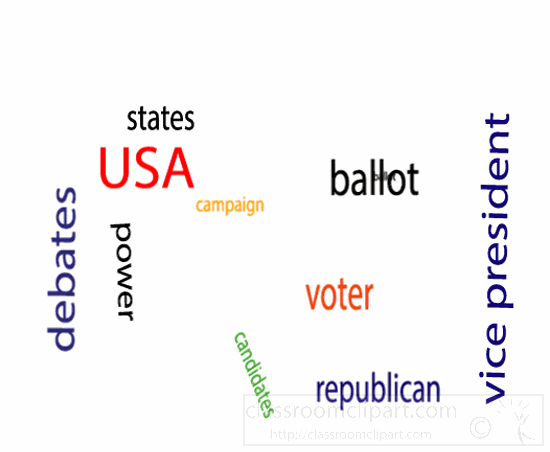Vote
|
|

Voting is a method of decision making wherein a group such as a meeting or an electorate attempts to gauge its opinion—usually as a final step following discussions or debates. Alternatives to voting include consensus decision making (which works to avoid polarization and the marginalization of dissent) and betting (as in an anticipatory democracy).
In a democracy, voting commonly implies election, i.e. a way for an electorate to select among candidates for office. In politics voting is the method by which the electorate of a democracy appoints representatives in its government.
A vote, or a ballot, is an individual's act of voting, by which he or she express support or preference for a certain motion (e.g. a proposed resolution), a certain candidate, or a certain selection of candidates. A secret ballot, the standard way to protect voters' political privacy, generally takes place at a polling station. (Compare postal ballot.)
Nevertheless, a country's having an election featuring the populace casting votes does not necessarily mean the country is democratic. Many authoritarian governments have "elections" but the candidates are pre-chosen and approved by elites, there is no competition, voter qualifications are restrictive, and voting is often a sham.
In some democracies, such as Australia, voting in a national election is not optional, but mandatory, on penalty of a significant fine.
| Contents |
Standard vote types
Different voting systems use different types of vote. Suppose that the options in some election are Alice, Bob, Charlie, Daniel, and Emily.
In a voting system that uses a single vote, the voter can select one of the five that they most approve of. First past the post uses single votes. So, a voter might vote for Charlie. This precludes him voting for anyone else.
In a voting system that uses a multiple vote, the voter can vote for any subset of the alternatives. So, a voter might vote for Alice, Bob, and Charlie, rejecting Daniel and Emily. Approval voting uses such multiple votes.
In a voting system that uses a ranked vote, the voter has to rank the alternatives in order of preference. For example, they might vote for Bob in first place, then Emily, then Alice, then Daniel, and finally Charlie. Many voting systems use ranked votes. See preference voting.
In a voting system that uses a scored vote (or range vote), the voter gives each alternative a number between one and ten (the upper and lower bounds may vary). See range voting.
Kenneth Arrow lists five characteristics of a fair voting system. Unfortunately, Arrow's impossibility theorem shows that it is impossible for any voting system to have all 5 characteristics at the same time.
More esoteric vote types
More complicated methods have also been proposed, principally as a theoretical tool. For example, one method would make an average vote look like the following:
- Alice > Charlie >>> Bob >> Emily > Daniel
This can be interpreted to mean: "Alice is my favourite, followed by Charlie, Bob, Emily, and Daniel, in that order. I am willing to compromise on Charlie if it allows me to avoid Bob, Emily, or Daniel being elected. If Alice and Charlie are eliminated, then I'll vote for Bob. In such a circumstance I am not willing to compromise on Emily to avoid the election of Daniel."
Complex voting systems that may allow for such statements attempt to deal with the need to accommodate expressions of both tolerances and preferences in voting.
Issues
Casting a vote expresses an implied willingness to participate in a common process with some shared outcome. Those who feel unable to express their limits or boundaries of tolerance in a voting system may be more likely to resist or fight or fail to support decisions made through it (more of an issue with parties or policies). Those who feel unable to express their real preferences may lack all enthusiasm for the choices or for the eventually chosen representative or leader. Any vote balances both kinds of considerations.
One common issue, especially in first-past-the-post systems, is that of the protest vote: one might "waste one's vote" on a minor party to send a signal of strong preference for a candidate or party that cannot win, or of intolerance for the "more mainstream" options. However it is difficult to tell from the vote alone whether one positively inclined to the minor party or negatively inclined to the major party. Russia offers its electors a "None of the Above" option, so that protest votes can be properly tallied. Other jurisdictions may record the incidence of (apparently deliberately) "spoiled" ballot papers.
Also, it is often not clear whether the voter really understands how his or her vote is counted in the voting system, especially with the more complex types. This often leads to issues with the results. Ballot design and the use of voting machines have particular importance, given this issue. Optimally participants in a vote should perceive the results, especially of a political vote, as fair. If fairness appears lacking, resistance to the results may lead at best to confusion, at worst to violence and even civil war, in the case of political rivals.
In an effort to make balloting cheaper and more transparent, Argentina introduced electronic voting for a gubernatorial election scheduled for 14 September 2003. The pilot test involved 500,000 voters distributed among 20 constituencies in the eastern Argentine province of Buenos Aires.
